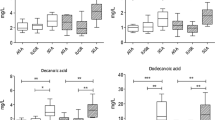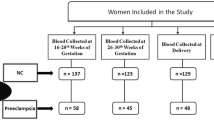Abstract
Background
The aim is to assess the levels of fatty acids (FAs) in pregnancies with small for gestational age (SGA) and adequate for gestational age (AGA) fetuses, constituting an association between FAs and fetal growth; according to the role of FA, lower levels were expected in SGA.
Materials and Methods
This was an analytical cross-sectional study including pregnant women with gestational ages of 26–36 weeks with AGA and constitutionally SGA fetuses diagnosed by ultrasonography. The levels of saturated, trans, monounsaturated, and polyunsaturated fatty acids were measured using centrifugation and liquid chromatography. Student’s t test and general linear model using gestational age as covariant were used to compare the levels of FAs and the groups (AGA and SGA). Chi-square was used to evaluate the association between groups and studied variables. Pearson correlation coefficient and linear regression were used to evaluate the correlation between the levels of FAs and gestational age.
Results
Peripheral blood was collected from 67 pregnant women, 3 of whom were excluded from the study. No significant statistical differences were observed between SGA (n = 40) and AGA (n = 24) in relation to saturated, trans, monounsaturated, and polyunsaturated fatty acids (p > 0.05). There was not significant correlation between saturated, trans, monounsaturated, and polyunsaturated FAs and gestational age (p > 0.05).
Conclusion
The levels of saturated, trans, monounsaturated, and polyunsaturated FAs were similar in constitutionally SGA and AGA fetuses.



Similar content being viewed by others

References
Frøen JF, Gardosi JO, Thurmann A, Francis A, Stray-Pedersen B. Restricted fetal growth in sudden intrauterine unexplained death. Acta Obstet Gynecol Scand. 2004;83(9):801–7.
Barker DJ, Gluckman PD, Godfrey KM, Harding JE, Owens JA, Robinson JS. Fetal nutrition and cardiovascular disease in adult life. Lancet. 1993;341(8850):938–41.
Mandruzzato GP, Bogatti P, Fisher L, Gigli C. The clinical significance of absent or reverse end diastolic flow in the fetal aorta and umbilical artery. Ultrasound Obstet Gynecol. 1991;1(3):192–6.
Lees C, Marlow N, Arabin B, et al. Perinatal morbidity and mortality in early-onset fetal growth restriction: cohort outcomes of the trial of randomized umbilical and fetal flow in Europe (TRUFFLE). Ultrasound Obstet Gynecol. 2013;42(4):400–8.
Waitzberg DL, Garla P. Contribution of omega-3 fatty acids for memory and cognitive function. Nutr Hosp. 2014;30(3):467–77.
Agostoni C, Marangoni F, Stival G, et al. Whole blood fatty acid composition differs in term versus mildly preterm infants: small versus matched appropriate for gestational age. Pediatr Res. 2008;64(3):298–302.
Brantsæter AL, Birgisdottir BE, Meltzer HM, et al. Maternal seafood consumption and infant birth weight, length and head circumference in the Norwegian Mother and Child Cohort Study. Br J Nutr. 2012;107(3):436–44.
Jones ML, Mark PJ, Waddell BJ. Maternal dietary omega-3 fatty acids and placental function. Reproduction. 2014;147(5):R143–52.
Saccone G, Saccone I, Berghella V. Omega-3 long-chain polyunsaturated fatty acids and fish oil supplementation during pregnancy: which evidence? J Matern Fetal Neonatal Med. 2016;29(15):2389–97.
Hadlock FP, Harrist RB, Martinez-Poyer J. In utero analysis of fetal growth: a sonographic weight standard. Radiology. 1991;181(1):129–33.
Gordijn SJ, Beune IM, Thilaganathan B, et al. Consensus definition of fetal growth restriction: a Delphi procedure. Ultrasound Obstet Gynecol. 2016;48(3):333–9.
Arduini D, Rizzo G. Normal values of pulsatility index from fetal vessels: a cross-sectional study on 1556 healthy fetuses. J Perinat Med. 1990;18(3):165–72.
Arias F. Accuracy of the middle-cerebral-to-umbilical-artery resistance index ratio in the prediction of neonatal outcome in patients at high risk for fetal and neonatal complications. Am J Obstet Gynecol. 1994;171(6):1541–5.
Kolarovic L, Fournier NC. A comparison of extraction methods for the isolation of phospholipids from biological sources. Anal Biochem. 1986;156(1):244–50.
Agren JJ, Julkunen A, Penttila I. Rapid separation of serum lipids for fatty acid analysis by a single aminopropyl column. J Lipid Res. 1992;33(12):1871–6.
Lepage G, Levy E, Ronco N, et al. Direct transesterification of plasma fatty acids for the diagnosis of essential fatty acid deficiency in cystic fibrosis. J Lipid Res. 1989;30(10):1483–90.
Cohen J. Statistical power analysis for the behavioral sciences. New York: Routledge Academic; 1988.
Bobiński R, Mikulska M. The ins and outs of maternal-fetal fatty acid metabolism. Acta Biochim Pol. 2015;62(3):499–507.
Chassen SS, Ferchaud-Roucher V, Gupta MB, et al. Alterations in placental long chain polyunsaturated fatty acid metabolism in human intrauterine growth restriction. Clin Sci (Lond). 2018;132(5):595–607.
Innes JK, Calder PC. Omega-6 fatty acids and inflammation. Prostaglandins Leukot Essent Fat Acids. 2018;132:41–8.
Szczuko M, Kikut J, Komorniak N, et al. The role of arachidonic and linoleic acid derivatives in pathological pregnancies and the human reproduction process. Int J Mol Sci. 2020;21(24):9628.
Vrachnis N, Karavolos S, Iliodromiti Z, et al. Impact of mediators present in amniotic fluid on preterm labour. In Vivo. 2012;26(5):799–812.
Nadeau-Vallée M, Obari D, Palacios J, et al. Sterile inflammation and pregnancy complications: a review. Reproduction. 2016;152(6):R277–92.
Walsh SW. Eicosanoids in preeclampsia. Prostaglandins Leukot Essent Fat Acids. 2004;70:223–32.
Larqué E, Gil-Sánchez A, Prieto-Sánchez MT, et al. Omega 3 fatty acids, gestation and pregnancy outcomes. Br J Nutr. 2012;107(Suppl 2):S77-84.
Jones ML, Mark PJ, Waddell BJ. Maternal omega-3 fatty acid intake increases placental labyrinthine antioxidant capacity but does not protect against fetal growth restriction induced by placental ischaemia-reperfusion injury. Reproduction. 2013;146(6):539–47.
Saccone G, Berghella V, Maruotti GM, et al. Omega-3 supplementation during pregnancy to prevent recurrent intrauterine growth restriction: systematic review and meta-analysis of randomized controlled trials. Ultrasound Obstet Gynecol. 2015;46(6):659–64.
Bobiński R, Mikulska M, Mojska H, et al. Assessment of the diet components of pregnant women as predictors of risk of preterm birth and born baby with low birth weight. Ginekol Pol. 2015;86(4):292–9.
Mani I, Dwarkanath P, Thomas T, et al. Maternal fat and fatty acid intake and birth outcomes in a South Indian population. Int J Epidemiol. 2016;45(2):523–31.
Smits JM, Elzenga HM, Reinoud Gemke JBJ, et al. The association between interpregnancy interval and birth weight: what is the role of maternal polyunsaturated fatty acid status? BMC Pregnancy Childbirth. 2013;13:23.
Van Eijsden M, Hornstra G, Wal MF, et al. Maternal n-3, n-6, and trans fatty acid profile early in pregnancy and term birth weight: a prospective cohort study. Am J Clin Nutr. 2008;87(4):887–95.
Sundrani DP, Karkhanis AR, Joshi SR. Peroxisome Proliferator-Activated Receptors (PPAR), fatty acids and microRNAs: Implications in women delivering low birth weight babies. Syst Biol Reprod Med. 2021;67(1):24–41.
Figueras F, Gratacós E. Update on the diagnosis and classification of fetal growth restriction and proposal of a stage-based management protocol. Fetal Diagn Ther. 2014;36(2):86–98.
Funding
This study was not funded.
Author information
Authors and Affiliations
Corresponding author
Ethics declarations
Conflicts of interest
The authors declare no conflict of interest.
Ethical Approval
This study was approved by the Research Ethics Committee of the Federal University of São Paulo (UNIFESP). All procedures performed in studies involving human participants were in accordance with the ethical standards of the institutional and/or national research committee and with the 1964 Helsinki declaration and its later amendments or comparable ethical standards.
Informed Consent
Informed consent was obtained from all individual participants included in the study.
Additional information
Publisher's Note
Springer Nature remains neutral with regard to jurisdictional claims in published maps and institutional affiliations.
Raquel Margiotte Grohmann is a Medical Assistant Isabela César Corazza - Gynecologist / Obstetrician Alberto. Borges Peixoto is an Adjunct Professor. Vivian Macedo Gomes Marçal is a Gynecologist / Obstetrician. Edward Araujo Júnior is an Associate Professor. Gabriele Tonni is a Full Professor Luciano Marcondes Machado Nardozza.
Rights and permissions
About this article
Cite this article
Grohmann, R.M., Corazza, I.C., Peixoto, A.B. et al. Maternal Blood Fatty Acid Levels in Small and Adequate for Gestational Age Pregnancies. J Obstet Gynecol India 72 (Suppl 1), 217–223 (2022). https://doi.org/10.1007/s13224-022-01632-z
Received:
Accepted:
Published:
Issue Date:
DOI: https://doi.org/10.1007/s13224-022-01632-z



